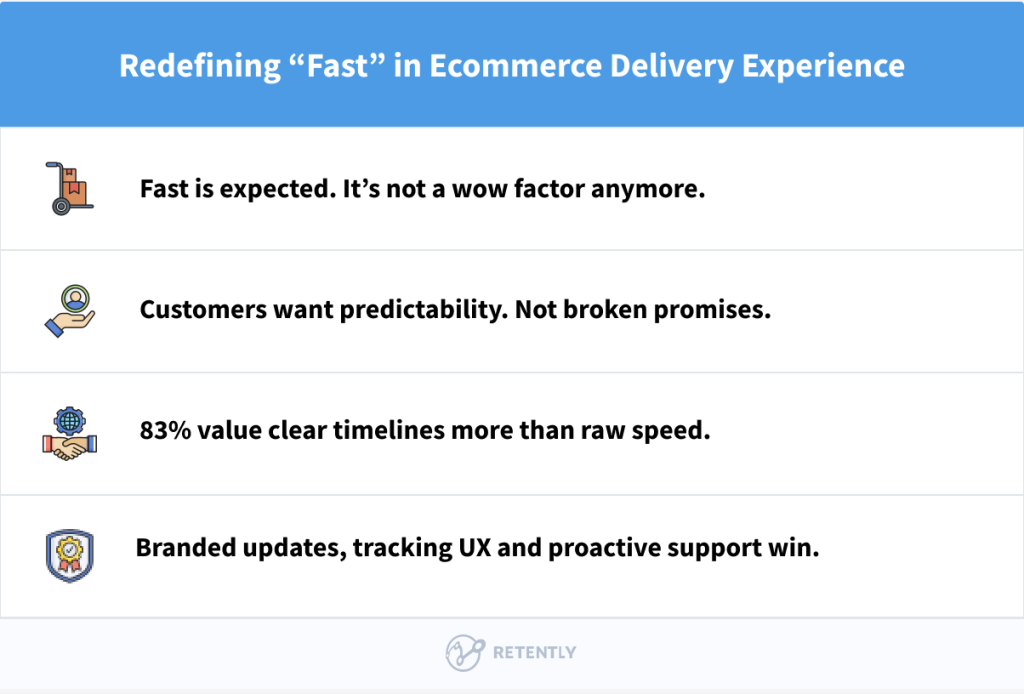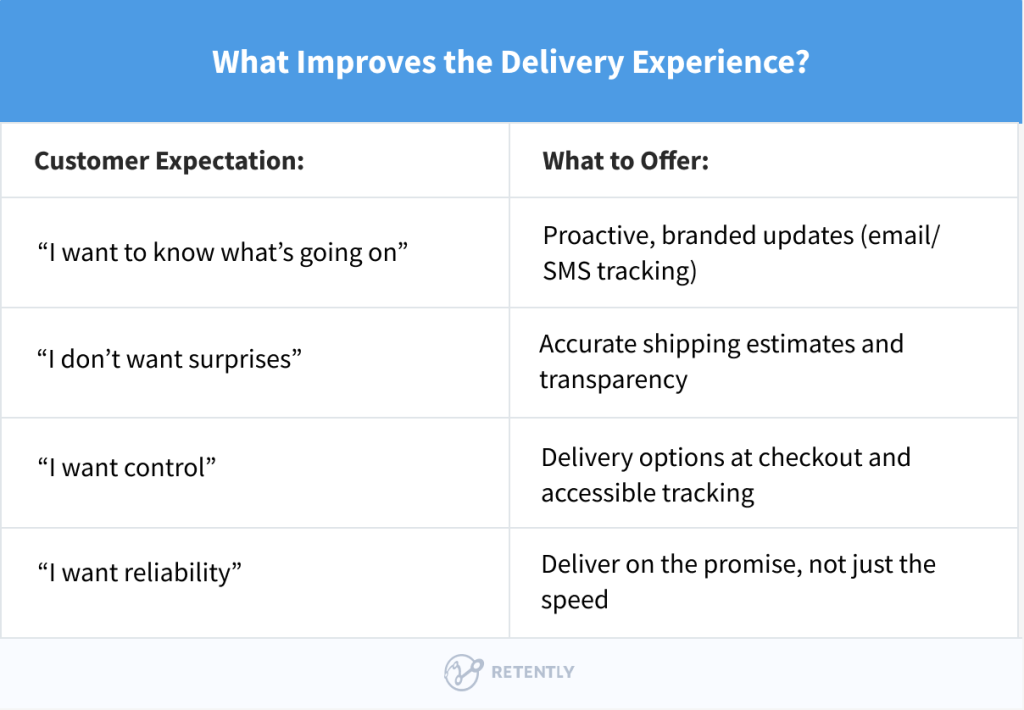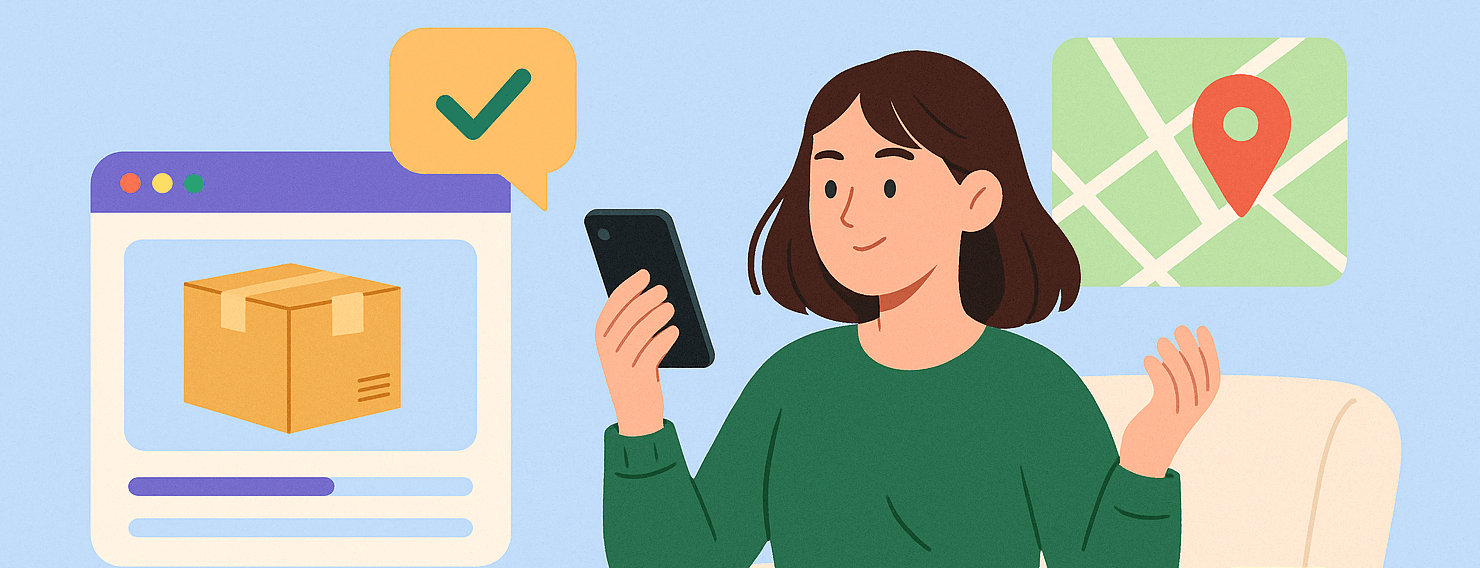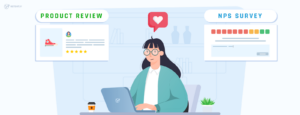Table of Contents
- Key Takeaways
- The Rise of “Fast” as a Standard, Not a Differentiator
- What Fast Doesn’t Fix: Delivery Speed vs. Delivery Experience
- Redefining Speed: What Customers Actually Want
- How Ecommerce Brands Can Deliver “Perceived Speed”
- Rethinking Your Metrics: Speed, CSAT and NPS
- Fast Is Expected, Experience Is the Advantage
- Conclusion: Deliver Trust, Not Just Speed
Remember when 2-day shipping felt like a total game-changer? That shift was thanks to Amazon Prime and it changed everything.
For a while, fast was the ultimate flex in ecommerce. If your brand could get products into customers’ hands faster than the competition, you won. It felt premium. It felt exciting.
But that was then. Now? Fast is just… expected.
According to a McKinsey study, over 90% of U.S. consumers consider 2- to 3-day delivery the norm, and nearly 1 in 3 expect same-day delivery from brands they shop with often. Fast shipping isn’t a perk anymore, it’s the price of entry.
So that begs the question: when everyone is fast, does “fast” even matter anymore?
And that’s what this article is all about – how customer expectations are shifting, and what ecommerce brands can actually do to stand out when “fast” is just the starting line.
Let’s dive in.
Key Takeaways
- Speed is not “dead”, it just doesn’t drive delight the way it used to. Today’s customers want something better: reliability, visibility, and trust.
- Speed is perception, not a stopwatch. Customers will wait longer if they feel informed, respected, and in control.
- Fast is expected, trust is remembered. Clear, calm, on-time delivery builds confidence, and confidence keeps customers coming back.
- Every delivery touchpoint is a brand moment. Don’t just send updates, extend your brand voice and experience beyond checkout.
- Stop racing Amazon and start serving your customers. You don’t need to beat Amazon on speed, you need to win on experience.
- Measure what matters. Post-delivery CSAT, support volume during shipping and transactional NPS tell the real story behind “speed”.
The Rise of “Fast” as a Standard, Not a Differentiator
Back in the early 2010s, if you could deliver in three days, you were ahead of the game. Customers would rave about it in reviews. But things have changed – a lot.
Thanks to Amazon Prime and later, Walmart, Target, and others jumping into the same-day and next-day delivery game, fast became the new normal; not the bonus, the baseline.
And now? Nine out of ten shoppers expect 2-3 day delivery as standard. That’s not just people hoping for fast shipping; that’s what they assume will happen when they hit “Buy Now.”
Retail giants have set the pace. With Amazon boasting over 200 million Prime members worldwide, consumers have been conditioned to expect not just fast delivery but fast + free + on time + trackable + convenient. And with Walmart and Target rolling out same-day and next-day options in most metro areas, the pressure is on. Even if you’re a niche DTC brand on Shopify, you’re still being compared to Amazon.
Here’s the kicker: everyone’s offering fast now. So being fast doesn’t make you special. It just keeps you in the game. It’s like having a mobile-friendly website – necessary, but not remarkable.
And let’s be real: most ecommerce businesses aren’t Amazon. You don’t own your own distribution network or have a warehouse in every zip code. Offering 2-day delivery might require higher costs, tighter margins, or risky promises that are hard to keep.
So what does all this mean?
It means that speed alone isn’t the lever it used to be. Customers might not thank you for being fast, but they’ll definitely call you out if you’re late, vague, or go silent during the delivery window.
Being “fast” might still get the package there on time, but it won’t win their loyalty.
What Fast Doesn’t Fix: Delivery Speed vs. Delivery Experience
So let’s say your order arrives in two days. Great, right? Well… maybe. It depends on how it felt getting there.
Here’s the problem: fast shipping doesn’t guarantee a great experience. If a customer places an order and hears nothing for two days – no tracking, updates or reassurance – they’re not thinking, “Wow, this is fast.” They’re thinking, “Wait, where is my order?”
And that’s where many ecommerce brands miss the mark. They focus so much on speed that they forget about clarity.
According to a Narvar report, 83% of shoppers said they care more about receiving accurate delivery estimates and proactive updates than how fast the item actually arrives. That’s a huge deal. It means customers are willing to wait a little longer as long as you tell them exactly what to expect and keep them informed.
Why does that matter so much? Because delivery isn’t just logistics, it’s emotional.
When customers aren’t sure where their package is, they feel anxious. When a promised ETA is missed without explanation, they feel powerless. And when tracking links lead to confusing third-party pages or outdated info, they feel frustrated.
This emotional friction can undo all the goodwill you earned during the shopping and checkout process.
Here’s the worst part: even if the package ends up arriving “on time”, the customer still walks away annoyed because you broke the trust. And the next time they shop, they’ll remember that tension, not the speed.
On the flip side, if your delivery experience is clear, transparent, and well-communicated, even if it takes an extra day, most customers won’t mind at all. In fact, they’ll feel taken care of.
So no, fast doesn’t automatically mean happy. Clarity beats speed every time.
Redefining Speed: What Customers Actually Want
So if fast isn’t the magic ingredient anymore… what is? Simple: predictability, transparency, and choice.
Let’s break it down:
1. Predictability: Clear ETAs Over Rushed Promises
Customers don’t just want things fast, they want to know when their stuff is coming. That’s it. No guessing games. No vague “Ships in 1-5 business days.” Just a real, honest ETA.
According to Narvar, 53% of shoppers said they’ll abandon their cart if they can’t see when something will arrive. That’s half your potential orders gone just because the delivery date is missing or unclear.
Predictability builds confidence. And confidence leads to conversions.
2. Transparency: Frequent, Branded Updates Build Trust
Think about the last time you placed an order and got a super detailed, on-brand tracking update:
“Hey Sam, your order just left the warehouse and is headed your way! Expect it Thursday by 8 PM.”
Now compare that to… “Your order has shipped.”
Which one makes you feel better?
Transparency means more than telling people where their package is. It’s about proactively communicating before the customer even thinks to ask. Great brands send updates at every stage: packed, shipped, in transit, out for delivery, delivered.
Even better? They do it in their own voice. Branded tracking pages and personalized emails make it feel like you’re still in the same shopping experience, even after the checkout is done.
This is especially powerful when something goes wrong because when you’ve already built trust, customers are more forgiving.
3. Flexibility: Let Customers Choose How They Want It
Not everyone needs lightning-fast shipping. Some want it cheap, some want it sustainable, while others just want options.
Offering flexibility at checkout, like:
- Eco-friendly delivery (slower, greener options)
- Click & Collect or in-store pickup
- Paid express delivery when it really matters
gives your customer control. And that control feels like convenience, even if it’s not the fastest option.
Fun fact? 76% of shoppers say they’d pay extra for more sustainable shipping, and 80% say they’d wait an extra day if it meant their delivery was more eco-friendly.
Turns out, fast isn’t always the priority. But being empowered to choose? That’s a win every time.
So no, speed doesn’t need to go away, it just needs a rebrand. It’s no longer about being the fastest, but the clearest, most honest, and most helpful at every step of the journey.

How Ecommerce Brands Can Deliver “Perceived Speed”
Here’s the good news: you don’t need your own fleet of trucks or an Amazon-style distribution empire to meet modern customer expectations. You just need to deliver what feels fast, even if it’s not.
That’s the power of perceived speed, creating an experience where customers feel like things are moving smoothly, confidently, and on time. And the best part? You can do this with tools you probably already have (or should).
Here’s how:
1. Use Automation to Send Proactive Delivery Updates
Don’t wait for your customers to ask, “Where’s my order?” Answer it before they even think about it.
Set up automated updates using tools like Klaviyo or Omnisend that fire off friendly emails or texts at key moments:
- Your order has been received
- It’s being packed
- It’s on the move
- Out for delivery
- Delivered!
These updates do more than inform, they reassure. They make the customer feel like you’ve got it handled. This transforms logistics into experience touchpoints and customers love it. And they reduce “Where’s my order?” tickets, which saves your support team a ton of time.
According to Wonderment, merchants using proactive shipping updates have reduced “Where is my order?” support tickets by 30% to 70%, while improving customer satisfaction and post-purchase retention.
The takeaway? What customers really want is:
- Clear confirmation emails
- Tracking links that actually work
- Proactive notifications about delays or delivery changes
2. Improve Post-Purchase Flows and Tracking Pages
Let’s talk tracking pages.
Most ecommerce brands hand off to a bland UPS or FedEx page the moment a product ships. But that’s a missed opportunity. You’ve just sent your customer into a brandless black hole.
Smart brands use branded tracking portals powered by AfterShip, Narvar, or even native tools in Shopify to keep customers in your ecosystem post-purchase.
Best brands have nailed this. Their tracking pages reflect their branding, use friendly language, and often include:
- Estimated arrival times
- Helpful tips for product care
- Links to FAQs or support
- Loyalty or referral program nudges
It’s a simple move that makes the experience feel polished, even if the delivery takes 3 or 4 days.
3. Match Shipping Promises to Operational Reality
Overpromising and underdelivering kill trust. If you rely on a 3PL or have complex logistics, it’s better to be honest than fast on paper. Instead of racing to promise speed:
- Show realistic delivery windows based on customer location
- Use real-time shipping estimates, not static copy.
- Use phrases like “Arrives by Friday” instead of “Standard Shipping”
- Add cut-off times for same-day dispatch (e.g., “Order by 2 PM for same-day shipping”)
- Be transparent about peak season delays or 3PL issues
- Flag slower items (e.g., pre-orders, handmade products) clearly
Shopify users can use apps like Estimated Delivery Date Range or Zonos to personalize delivery timelines based on cart and region.
4. Overcommunicate During Delays
Things go wrong. It happens. But silence? That’s what kills trust.
When you know a package is delayed, whether due to weather, inventory, or a carrier backlog, tell the customer immediately. Don’t wait until they email you upset.
Send a quick, honest message like:
“Hey, just a heads-up – your order’s been slightly delayed. It’s now expected to arrive on Friday instead of Thursday. We’ll keep you updated every step of the way.”
This small gesture can flip frustration into appreciation.
In fact, customers who experience a delay and get proactive updates are often more loyal than those whose order arrived on time with zero communication. (Yes, really.)
5. Train Support Teams for Delivery Disruptions
A delay doesn’t have to mean disaster, how you handle it can actually increase loyalty. Give your CX team the tools to:
- Reach out when delays are flagged in the system
- Offer small gestures (free shipping next time, $5 coupon)
- Use macros that are on-brand but human
- Follow up after a bad experience to close the loop
What’s more, according to the service recovery paradox, customers who experience a problem and have it handled well often become more loyal than those who had no issues.
6. Look to Brands Doing It Right
Let’s call out a few brands that are crushing the perceived speed game:
- Apple: Apple provides exact ETAs and delivery windows (often to the hour). Their tracking pages are minimal and clear, and even when products take longer, customers trust the timeline.
- Nike: Nike offers multiple fulfillment options, including express and member-exclusive delivery. Their post-purchase emails often promote loyalty perks and upcoming drops, keeping customers engaged during the wait, not just informed.
- IKEA: While not known for speed, IKEA excels in setting expectations upfront. They break down delivery schedules clearly and allow scheduled drop-offs. Post-purchase emails include assembly videos and product pairings adding value beyond speed.
- Zara: Zara provides precise ETAs at checkout, offers express and in-store pickup, and updates customers with timely, branded emails. Their fashion-savvy audience gets both style and clarity and their returns experience is seamless.
- Sephora: Sephora uses delivery updates as a brand engagement opportunity. Emails often include tutorials, product tips, or cross-sell suggestions reinforcing value between checkout and arrival. Their shipping is fast, but the real win is in the experience around it.
- ASOS: ASOS ships internationally but still keeps things predictable and proactive. Their branded tracking pages and consistent updates make it easy to follow an order’s progress. Their returns flow is top-tier, which helps protect customer trust even when issues arise.
These brands prove that even if you can’t ship same-day, you can still create a world-class delivery experience. If your delivery communication is smooth, proactive, and on-brand, the wait feels shorter even if it’s not. And that’s how you win with perceived speed.
Quick Recap: What Improves the Delivery Experience?

Check out these tools to help you out:
- AfterShip or Narvar for branded tracking pages and updates
- Klaviyo or Omnisend flows to trigger emails at every delivery stage
- Route or Wonderment to reduce WISMO (“Where Is My Order?”) tickets
- Gorgias or Zendesk for integrated support in case something goes wrong
Bottom line? Delivery is your brand’s last mile of storytelling. If the box shows up fast but everything in the experience felt rushed, cold, or confusing you didn’t win.
Rethinking Your Metrics: Speed, CSAT and NPS
Let’s get real for a sec: fast shipping doesn’t matter if the customer still walks away annoyed.
This is why ecommerce brands need to shift their focus from just “How fast did it arrive?” to “How did the customer feel about the whole experience?”
Speed is only part of the story. Satisfaction is the metric that tells the truth.
Why You Should Track CSAT After Delivery
You’ve probably seen Customer Satisfaction (CSAT) surveys pop up after a customer contacts support or completes a purchase. But one of the most overlooked (and most insightful) moments to ask is right after delivery.
Why? Because this is when your customer:
- Has been through your full logistics flow
- Has felt any tension or delight
- Is forming their post-purchase impression of your brand
A simple “How satisfied are you with your delivery experience?” rating can uncover:
- Confusion about tracking
- Packaging/damage issues
- Fulfillment delays you weren’t even aware of
Don’t just ask about the product. Ask about the delivery. You’ll get more honest, actionable feedback.
How Transactional NPS Reflects Communication Gaps
Transactional NPS (Net Promoter Score) is usually sent a few days after delivery, and it’s a great way to gauge loyalty and referral potential. But here’s what many brands miss:
When customers leave low NPS scores, they often don’t complain about the product. They complain about delivery silence, broken ETAs, or “not knowing what was going on.”
You might see comments like:
- “Shipping took longer than expected.”
- “I had no idea when it was going to arrive.”
- “It came late and I wasn’t updated.”
Even if the product is perfect, a rough delivery experience drags your brand perception down. And NPS is very sensitive to emotional friction like this.
Metrics That Actually Matter for the Delivery Experience
If you want a more complete view of how delivery affects CX, start tracking these:
- On-time delivery percentage: Shows how often you’re meeting promised ETAs. Overpromising hurts more than a slightly longer, honest timeline.
- Post-delivery CSAT: Direct feedback about how the customer felt once the order landed.
- Transactional NPS: Loyalty indicator based on the full experience, not just the product.
- Support ticket volume during shipping window: High volume? That’s a red flag: your customers don’t feel informed or in control.
These data points help you see past the stopwatch and into how customers are really experiencing your brand. Track what actually affects customer trust. Because you can’t fix what you don’t measure – and perception matters more than the clock.
The Takeaway? Use Feedback to Catch Delivery Issues Early
Delivery isn’t just logistics, it’s emotional. Ask how customers felt after delivery, not just after checkout. Add these simple feedback loops:
- Send CSAT or 5-star survey 1-2 days after delivery
- Add at least one open-ended question for context: “Was your delivery experience what you expected?”
- Use transactional NPS 3-5 days post-delivery, especially for first-time buyers. You’ll catch sentiment when it’s fresh.
- Segment by carrier, region, or shipping speed to surface trends.
Fast Is Expected, Experience Is the Advantage
Let’s bring it all home.
Fast shipping? It’s great. But it’s not a “wow” anymore, it’s just what everyone expects. And when the rest of the experience feels clunky, confusing, or cold… speed becomes irrelevant.
In fact, fast can feel slow when your customer doesn’t know what’s happening.
Think about it: If a customer places an order and hears nothing for two days, even a 48-hour delivery feels like forever. But if that same customer gets a confirmation email, a shipping update, a branded tracking link, and a heads-up that it’s on the way? That wait feels shorter even if it’s not.
Speed is invisible. The experience is what they remember.
That means what happens between the “Thanks for your order” and the package arriving at the door is what makes or breaks your customer’s trust. And trust is fragile.
According to the “State of Shipping” report, 50% of online shoppers say they won’t return to a brand after a poor delivery experience, even if the product was great. That’s a loyalty killer.
So what actually gives you the edge?
- Clarity: Clear ETAs. No guessing.
- Care: Branded, proactive updates that show you’re paying attention.
- Consistency: Deliver on what you promise, every time.
It’s not about racing Amazon but being reliable, transparent, and easy to love. That’s what builds loyalty and turns first-time buyers into repeat customers.
If you haven’t done it yet, audit your post-purchase flow using this Delivery Experience Checklist for your brand. Ask yourself:
- Are shipping expectations clear at checkout and in post-purchase emails?
- Are your delivery updates timely and helpful?
- Do you measure CSAT or NPS specifically for delivery?
- Is your tracking page a branded experience or just a carrier redirect?
- Can your support team handle shipping issues with empathy and speed?
- Are you proactively handling delays before customers ask?
- Are you using delivery emails to reinforce loyalty, not just send logistics?
If you answered “no” to any of these, that’s your growth opportunity.
Conclusion: Deliver Trust, Not Just Speed
Let’s be clear, fast shipping still matters. Customers expect it as part of the modern ecommerce playbook. But on its own, it’s no longer the reason people choose you or come back to you.
Today, speed is just one part of a much bigger picture. What really earns trust and builds loyalty is everything around that speed:
- The clarity of your delivery promise
- The tone of your updates
- The ease of tracking and returning
- The feeling that your brand didn’t disappear after checkout
The most successful ecommerce brands – whether they’re scaling through Shopify, competing in DTC, or building mid-market infrastructure – aren’t the fastest. They’re the most consistent, the most transparent, and the most emotionally intelligent when it comes to the post-purchase experience.
And that’s where the true value of customer experience metrics like CSAT, CES and NPS comes in. These aren’t just vanity numbers, they’re signals of where your delivery process meets (or fails) emotional expectations. Test Retently in a free trial and start collecting actionable data in minutes.
Remember, redefining “fast” in ecommerce is about building a trustworthy, responsive, and human post-purchase experience – one that customers remember, appreciate, and recommend. So don’t just ship quickly, ship with intention. Because in a time where speed is everywhere, the best brands stand out by how they make the wait feel.





























 Christina Sol
Christina Sol 


 Alex Bitca
Alex Bitca 


 Greg Raileanu
Greg Raileanu